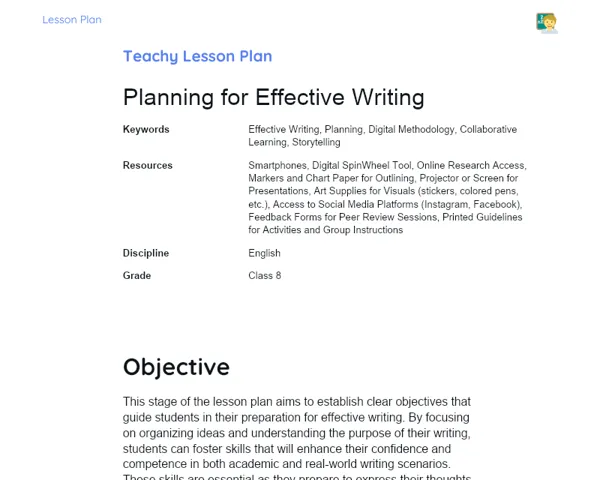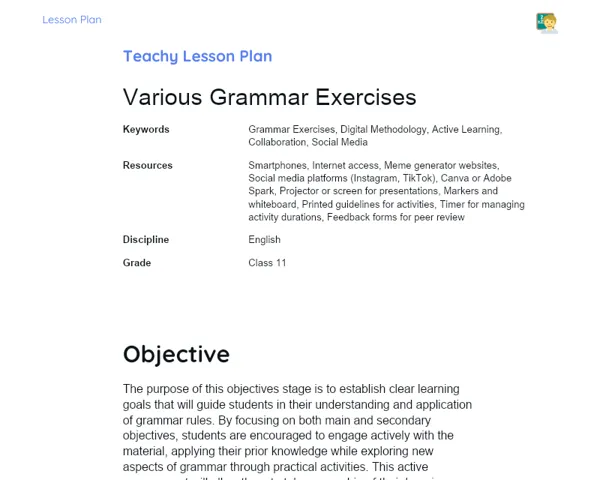Lesson Plan | Socioemotional Learning | Indicative of Questions and Answers: Introduction
| Keywords | Self-awareness, Self-control, Responsible Decision Making, Social Skills, Social Awareness, Mindfulness, Structure of Questions in English, Question Words, Auxiliary Verbs, Responses in English, Interaction, Collaboration, Emotional Regulation, Reflection, Personal Goals, Academic Goals |
| Resources | Cards with question words, Cards with example questions, Whiteboard and markers, Paper and pens for students, Clock or timer, Adequate space for group activities |
| Codes | - |
| Grade | 4th grade |
| Discipline | English |
Objective
Duration: 10 to 15 minutes
The aim of this stage is to provide students with a fundamental understanding of the topic, laying the groundwork for future learning. Additionally, this stage seeks to engage students and prepare their minds and emotions, fostering self-awareness and self-control as they delve into the subject.
Objective Utama
1. Identify and understand the basic structure of a question in English.
2. Respond appropriately to questions in English using the correct structure.
Introduction
Duration: 15 to 20 minutes
Emotional Warmup Activity
Mindfulness for Enhanced Focus and Concentration
The Mindfulness activity encourages students to focus completely on the present moment, helping to alleviate anxiety and enhance concentration. This practice fosters greater self-awareness and self-control, vital for a productive classroom environment.
1. Request that the students sit comfortably with their backs straight and feet flat on the floor.
2. Ask them to close their eyes or softly gaze at a fixed point ahead.
3. Guide them to focus on their breath, noticing the air flowing in and out through their nostrils.
4. After a short while, instruct them to breathe in deeply through the nose for a count of four, hold for four seconds, and slowly exhale through the mouth for a count of six.
5. Repeat this deep breathing three times.
6. Then, prompt them to return to normal breathing while still being mindful of their breath.
7. If thoughts come up, encourage them to acknowledge these thoughts calmly and gently redirect their focus back to their breath.
8. After about five minutes, invite them to open their eyes slowly and do some light stretching to shift their attention back to the classroom.
Content Contextualization
Learning to ask and answer questions correctly in English is a crucial skill that transcends the classroom walls. For instance, imagine you are traveling in an English-speaking country needing to ask for directions or make new friends. Knowing how to appropriately structure your questions and answers not only helps in communicating effectively but also builds your confidence in social interactions. Additionally, the ability to ask and respond correctly is essential in various social and professional contexts. Developing this skill set will help students to form healthy and effective relationships both at school and in their personal lives, enabling clear and respectful communication of needs and understanding others.
Development
Duration: 60 to 75 minutes
Theory Guide
Duration: 20 to 25 minutes
1. Basic Structure of Questions in English: Clarify that questions in English typically consist of question words ('wh- words'), auxiliary verbs, and subjects. For example: 'What’s your name?'; 'Where do you stay?'.
2. Question Words: Introduce the main question words in English, like: What, Where, When, Why, Who, How.
3. Auxiliary Verbs: Discuss the role of auxiliary verbs in questions, such as 'do/does' and 'is/are'. Provide examples: 'Do you enjoy pizza?'; 'Is he coming over?'.
4. Response Structure: Emphasize that responses should be complete and reflect the question’s structure. For instance, in response to 'Where do you stay?', one could say 'I stay in Mumbai.'.
5. Practical Examples: Provide extra examples and encourage students to create their own questions and answers. For example: 'What’s your favorite color?'; 'My favorite color is blue.'
Activity with Socioemotional Feedback
Duration: 25 to 30 minutes
Question and Answer Game
Students will pair up or form small groups to practice crafting and responding to questions in English. This activity will help reinforce their theoretical knowledge while developing their social and emotional skills through interaction and collaboration.
1. Divide the students into pairs or small groups of 3 to 4.
2. Hand out cards with various question words and sample questions.
3. Instruct students to create new questions using the provided question words within their groups.
4. Each group will then ask their questions to another group, who must provide complete responses.
5. After each round, encourage students to discuss their feelings during the activity—whether they found it easy or challenging and why.
6. Wrap up with a feedback session where each group shares an interesting or tricky question and answer.
Discussion and Group Feedback
After the activity, gather the students in a circle to facilitate a group discussion. Use the RULER method to steer the conversation:
Recognize: Ask students how they felt while asking and answering questions. Understand: Delve into the reasons behind these emotions by exploring what made the activity easier or harder.
Label: Help students articulate the emotions they experienced, like anxiety, excitement, or frustration. Express: Encourage them to share their thoughts respectfully and openly. Regulate: Discuss approaches for managing difficult emotions—like seeking help or practicing at home.
Conclusion
Duration: 15 to 20 minutes
Reflection and Emotional Regulation
Encourage students to write a short paragraph or join in a group discussion about the challenges they faced during the lesson. Ask them about their feelings while asking and answering questions in English, prompting them to reflect on how they managed their emotions. Inquire if they experienced anxiety, excitement, or frustration, and how they navigated those feelings. Ask students to discuss strategies they have used or could implement in the future to manage their emotions in challenging situations.
Objective: This subsection aims to promote self-assessment and emotional regulation, helping students develop effective strategies for handling challenging scenarios. Such reflections will enhance their self-awareness and self-control, which are crucial for personal and academic progress.
Glimpse into the Future
To wrap up the lesson, invite students to set personal and academic goals related to the lesson content. Explain that these goals could involve enhancing their ability to ask questions in English, practicing more at home, or working on emotional skills like confidence while speaking in public.
Penetapan Objective:
1. Enhance the ability to form questions in English.
2. Practice responding confidently to questions in English.
3. Aim for clear and respectful expression of emotions.
4. Develop coping strategies for anxiety during public speaking.
5. Integrate mindfulness practices into daily routines to bolster focus and self-control. Objective: This subsection's aim is to bolster students' autonomy and the practical application of their learning, promoting continuity in both academic and personal development. By establishing goals, students are encouraged to take responsibility for their growth in language skills and emotional intelligence.


